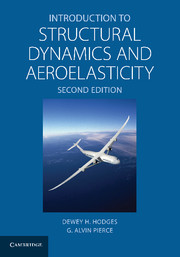1 - Introduction
Published online by Cambridge University Press: 05 June 2012
Summary
“Aeroelasticity” is the term used to denote the field of study concerned with the interaction between the deformation of an elastic structure in an airstream and the resulting aerodynamic force. The interdisciplinary nature of the field is best illustrated by Fig. 1.1, which originated with Professor A. R. Collar in the 1940s. This triangle depicts interactions among the three disciplines of aerodynamics, dynamics, and elasticity. Classical aerodynamic theories provide a prediction of the forces acting on a body of a given shape. Elasticity provides a prediction of the shape of an elastic body under a given load. Dynamics introduces the effects of inertial forces. With the knowledge of elementary aerodynamics, dynamics, and elasticity, students are in a position to look at problems in which two or more of these phenomena interact. The field of flight mechanics involves the interaction between aerodynamics and dynamics, which most undergraduate students in an aeronautics/aeronautical engineering curriculum have studied in a separate course by their senior year. This text considers the three remaining areas of interaction, as follows:
between elasticity and dynamics (i.e., structural dynamics)
between aerodynamics and elasticity (i.e., static aeroelasticity)
among all three (i.e., dynamic aeroelasticity)
Because of their importance to aerospace system design, these areas are also appropriate for study in an undergraduate aeronautics/aeronautical engineering curriculum. In aeroelasticity, one finds that the loads depend on the deformation (i.e., aerodynamics) and that the deformation depends on the loads (i.e., structural mechanics/dynamics); thus, one has a coupled problem.
- Type
- Chapter
- Information
- Publisher: Cambridge University PressPrint publication year: 2011



